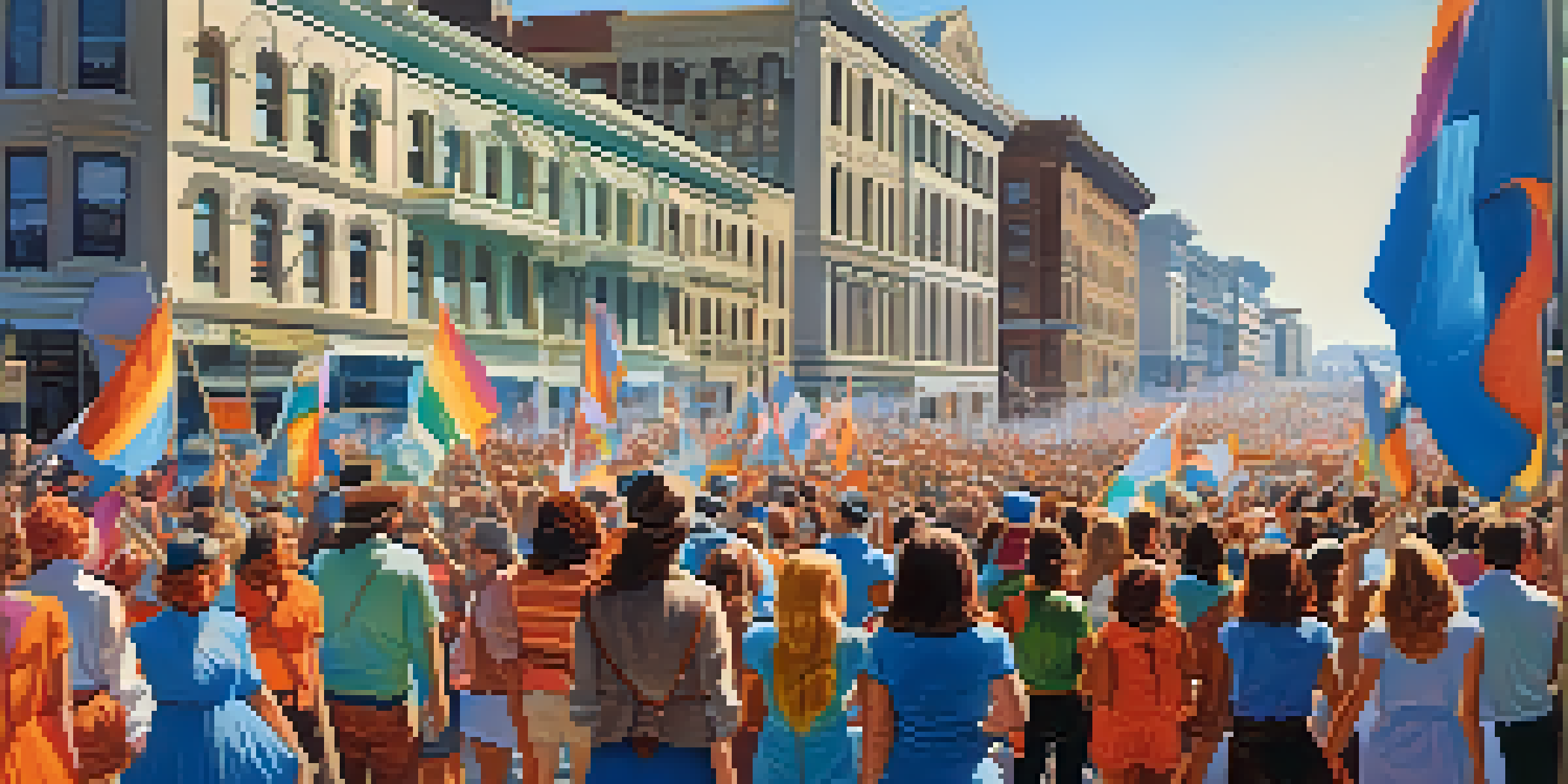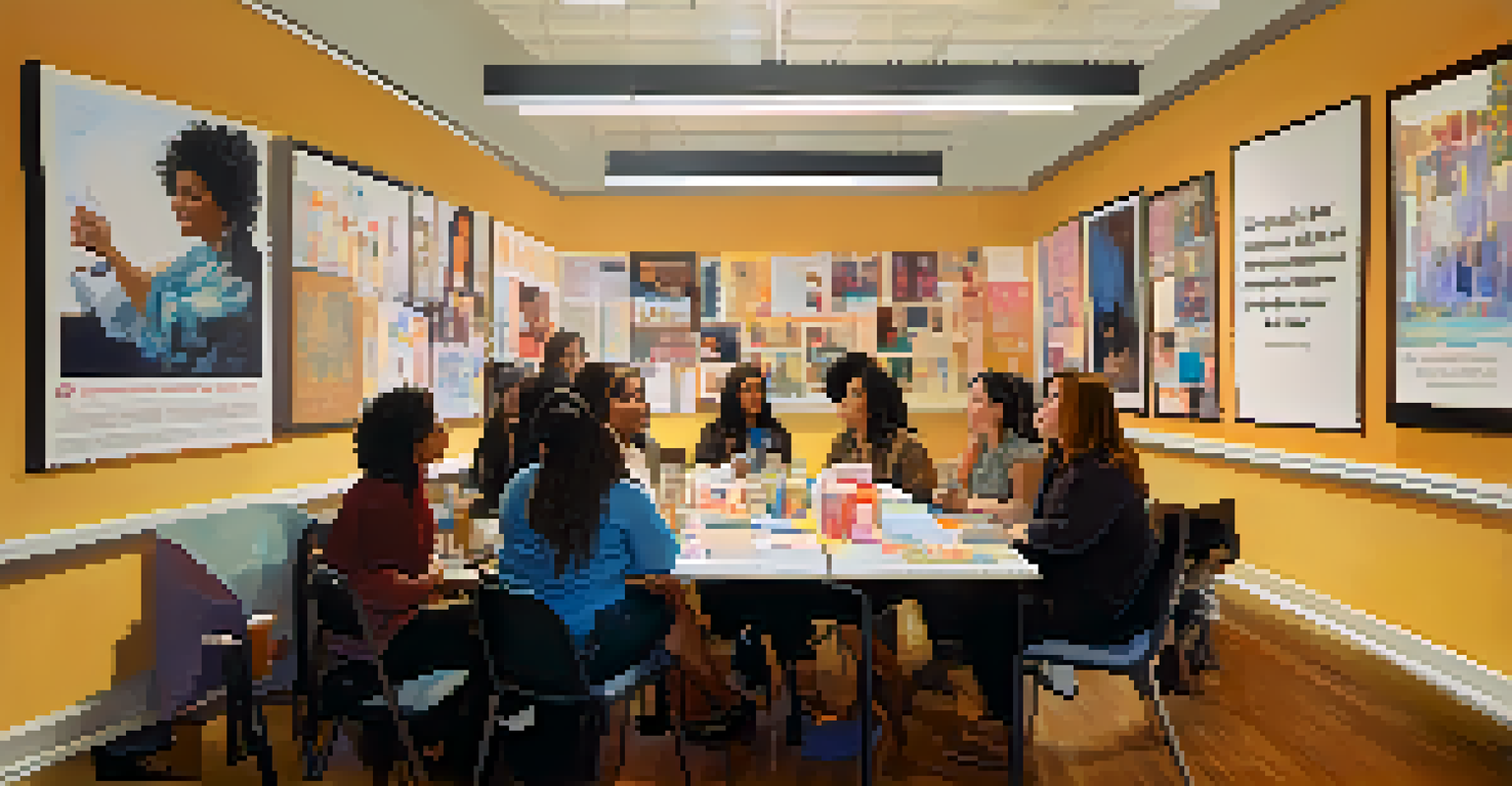Women's Liberation Movement: San Francisco's Influence

The Roots of the Women's Liberation Movement
The Women's Liberation Movement emerged in the 1960s, aiming to address gender inequality and promote women's rights. It was a time of significant social change, fueled by various civil rights movements. Activism began to gain momentum as women sought equal opportunities in all areas of life, from the workplace to personal freedoms. San Francisco, with its vibrant culture, became a key player in this transformative era.
The most common way people give up their power is by thinking they don’t have any.
In San Francisco, the convergence of liberal politics, artistic expression, and countercultural movements created a fertile ground for women's activism. Women began organizing rallies, consciousness-raising groups, and publications dedicated to women's issues. The city's unique blend of diversity and innovation encouraged bold ideas to flourish, making it a hub for change. This energy laid the groundwork for a more organized movement.
The roots of the movement in San Francisco can be traced back to influential figures and organizations that championed women's rights. From Betty Friedan's 'The Feminine Mystique' to the establishment of groups like the National Organization for Women (NOW), the city played a crucial role in amplifying these voices. Together, these efforts set the stage for a national dialogue on gender equality.
Key Events That Shaped San Francisco's Influence
San Francisco hosted several significant events that galvanized the Women's Liberation Movement. One of the most notable was the 1970 Women's Strike for Equality, which saw thousands of women marching to demand equal pay, reproductive rights, and an end to gender discrimination. The sheer number of participants showcased the city's commitment to advancing women's rights and inspired similar actions across the country.

In addition, the creation of the San Francisco Women's Center in 1971 provided a safe space for women to gather, share their experiences, and organize. This center became a focal point for feminist activism, offering resources, workshops, and support networks. It played a vital role in empowering women and fostering a sense of community, which was essential for the movement's growth.
San Francisco: A Hub for Activism
The city played a pivotal role in the Women's Liberation Movement by fostering a culture of activism and organizing significant events that advanced women's rights.
Events like the Women's Music Festival and various feminist art exhibits also contributed to raising awareness and promoting women's issues. These gatherings not only celebrated women's achievements but also challenged societal norms. Such initiatives highlighted the creative power of women and encouraged them to redefine their roles in society.
The Role of Education in the Movement
Education was a cornerstone of the Women's Liberation Movement in San Francisco. Activists recognized that knowledge was key to empowerment, leading to the establishment of programs aimed at educating women about their rights. Workshops on topics like reproductive health, workplace rights, and self-defense became increasingly popular, helping women to assert their independence.
Feminism is the radical notion that women are human beings.
Universities in the area also played a pivotal role, with institutions like San Francisco State University hosting feminist studies programs and courses. These academic initiatives not only educated students but also produced influential research that informed the broader movement. As women gained access to higher education, they began to occupy roles as leaders and advocates in their communities.
Moreover, the connection between education and activism was evident in the rise of student-led organizations. These groups organized protests, discussions, and campaigns to highlight issues affecting women on campus and beyond. By fostering a culture of critical thinking and activism, these educational efforts had a lasting impact on the movement.
Intersectionality: Embracing Diverse Experiences
As the Women's Liberation Movement evolved, it became increasingly aware of the importance of intersectionality. This concept emphasizes that individuals experience oppression differently based on various factors like race, class, and sexual orientation. In San Francisco, activists began to recognize that the fight for women's rights must include the voices of marginalized groups.
The city's diverse population provided a unique backdrop for this shift. Women of color, LGBTQ+ individuals, and working-class women brought their experiences and challenges to the forefront of the movement. By amplifying these voices, the movement became richer and more inclusive, addressing issues that affected a broader spectrum of women.
Intersectionality Enriches the Movement
The movement evolved to embrace intersectionality, recognizing diverse experiences and amplifying the voices of marginalized groups to create a more inclusive fight for women's rights.
Intersectionality not only strengthened the movement but also fostered alliances with other social justice causes. Collaborations with racial justice activists, LGBTQ+ rights advocates, and labor organizations created a unified front against discrimination. This holistic approach ensured that the fight for women's liberation was comprehensive and impactful.
Media's Role in Amplifying Women's Voices
In an age before social media, traditional media played a crucial role in shaping public perceptions of the Women's Liberation Movement. Newspapers, magazines, and television programs began to feature stories about women's rights and activism in San Francisco. This coverage helped to legitimize the movement and attract more supporters, encouraging women to join the fight.
Local publications, like the 'San Francisco Women's Press,' provided a platform for women to share their stories and ideas. These grassroots efforts were instrumental in creating a sense of community among women and spreading awareness about the issues they faced. The media became a powerful tool for activism, helping to articulate the goals and aspirations of the movement.
Additionally, the rise of feminist literature and art helped to disseminate the movement's messages. Books, poetry, and visual art created by women addressed themes of empowerment, identity, and resistance. This creative expression not only resonated with many but also inspired a generation of women to embrace their voices and pursue change.
Legislative Achievements and Milestones
The activism in San Francisco led to significant legislative achievements that advanced women's rights. The city became known for its progressive policies, including the establishment of equal pay legislation and workplace protections for women. These legal milestones were a direct result of the tireless efforts of activists who lobbied for change and held those in power accountable.
Moreover, San Francisco's emphasis on reproductive rights positioned it as a leader in the fight for women's autonomy. The city was at the forefront of advocating for access to contraception and safe, legal abortion services. This commitment to reproductive justice became a central tenet of the broader women's movement, influencing policies across the nation.
Legislative Wins and Modern Advocacy
Activism in San Francisco led to key legislative achievements for women's rights, and the legacy of this movement continues to inspire modern efforts addressing contemporary issues.
The lobbying efforts of local organizations, such as the Women's Coalition, played a pivotal role in these achievements. By mobilizing community members and engaging with lawmakers, they ensured that women's voices were heard in decision-making processes. The impact of these legislative victories continues to be felt today, as they laid the groundwork for ongoing advocacy.
Continuing the Legacy: Modern Activism in San Francisco
The legacy of the Women's Liberation Movement in San Francisco continues to inspire modern activism. Today's advocates build upon the foundations laid by previous generations, tackling contemporary issues such as pay equity, reproductive rights, and gender-based violence. The spirit of empowerment and activism remains strong in the city, as new leaders emerge to carry the torch.
San Francisco is home to numerous organizations dedicated to women's rights, such as Planned Parenthood and the Women's Foundation. These groups not only provide essential services but also engage in advocacy work to ensure women's voices are represented in policy discussions. Their efforts are a testament to the enduring importance of the movement's goals.

Moreover, the rise of social media has transformed the landscape of activism, allowing for greater visibility and engagement. Campaigns like #MeToo and #TimesUp have gained traction in San Francisco, as activists leverage digital platforms to amplify their messages and reach wider audiences. This evolution demonstrates the adaptability of the women's movement and its commitment to addressing the challenges of today.